Like so many parts of the garment, pockets seem like simple, insignificant little things but in reality are quite complex and pose certain challengers to cutter and tailor alike.
One of the first considerations is whether there are stripes or checks to be matched. If you look at most RTW, and even some bespoke garments, the lines of a pocket flap will match the jacket nicely below the flap, but seldom above the flap. The jets (the thin welts above and below the flap) never match on RTW but on many bespoke garments, will match nicely as in the photo below.
The former is due to the way the jacket front is cut- the dart is cut in such a manner as to allow a little extra length over the abdomen area, and helps keep the lower front from kicking out. It is also easier to manufacture in this way. In this photo, however, you will notice that the check matches above as well as below the flap- this is a particularly large check so I decided to cut the front differently to allow the check to continue undisturbed. I could also have cut the side body in one part with the front, thus allowing the flap to match all the way (notice that it no longer matches the side body), but I like a very trim garment and the fit is much better with a separate side body. Notice also that the jet matches the flap and the front, in fact, it is difficult to spot because a) it is matched and b) it was made by hand.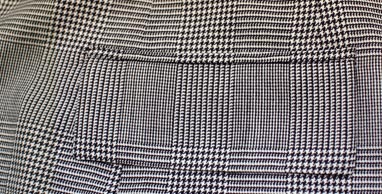
The next consideration is the ticket pocket, if one chooses to include one. Notice on my light grey jacket that I have chosen to line up the ticket pocket with the lower pocket. This cloth is plain so I was able to do this pleasingly. Looking back at the checked jacked above, you will notice that the check distorst above the pocket due to the dart. If I were to line up the ticket pocket with the lower pocket, it would match for 1/2" only. Some choose to place the pocket there anyway, others move it back behind the dart- this was the checks will match much better. We see this done both ways and I don't think there is a definitive answer to the question- which is better?
The underside, before attaching the pocket bag.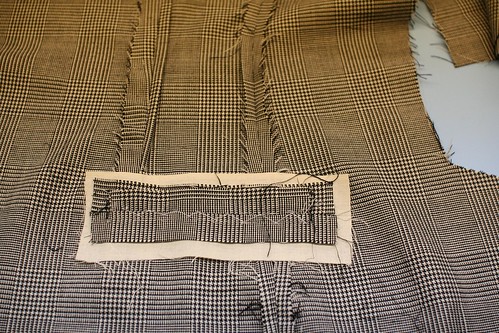
Once decisions about how the pocket will be matched to the front have been the, the jacket can be cut. In modern factories the flaps are made with jigs- special templates in the shape shape of the flap, placed on the sewing machine, a button is pressed, and the machine sews and trims the flap in one step. The flap is turned and pressed, again on a template in the form of the flap, in order to get a correct and consistent shape. Then things get complex. Machines now exist onto which the operator places a rectangle of fabric, a pellon stay, then the flap, then the pocket bag. Guided by a laser on the machine, the operator is able to place the jacket in such a way as that flap will match the front with no extra effort on their part. The machine then folds the rectangle of fabric to for the two jets, sets the flap and pocket bag, sews all together, then cuts the pocket, all in one step which takes only a few seconds. This is the result (the ticket pocket is done in another step);
The pocket is turned and the bag is tacked to the top, it is pressed, and that is it. In all, a few minutes. The jets, however, can't be matched in this way so no attempt is made; in fact, the rectangle is cut on the length of the cloth instead of the width so the stripe will run the length of the jet.
Let's now consider the hand-made method. Two rectangles of fabric are sewn by plain machine to the front in a very slight curve; they are then pressed, cut, the seams opened, basted in place, the rectangles are turned over the open seam, basted, then a prick stitch is sewn in the seam to close the jets. Done in this way, the checks or stripes can be matched- in the photo above, if it weren't for the very slight bowing of the pocket, the jet would be virtually invisible.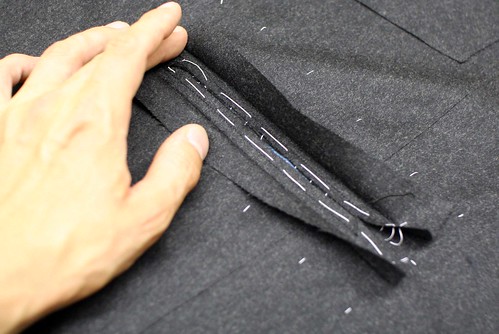
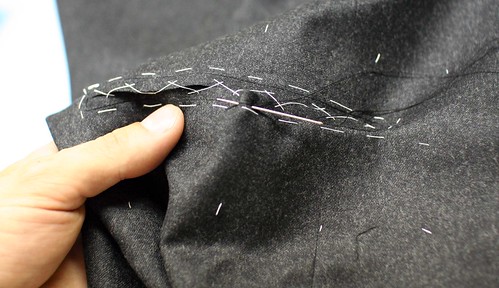
A little half-moon is often sewn by hand at the ends of the jets to tack them in place. This can also be done my automatic machine, but it is much nicer looking when done (properly) by hand;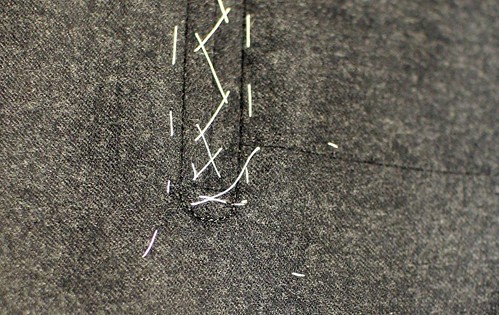
The whole process takes me about an hour for a pair of pockets, and requires a lot of care and patience. In fact, most tailors, including those on the Row, send their work out to pocket makers who specialise in this, since it is such a finnicky job. The result is a much softer, finer, flatter pocket with a much more discreet profile.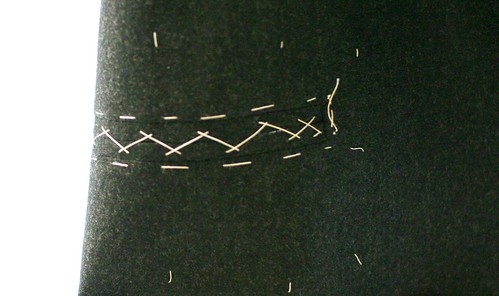
Compare this to a pocket on a RTW garment.
There is, of course, another way of making the jetted pocket without an automatic machine, but in a way which resembles it. This method is quick and easy and I use it to make the breast pockets on my lining, and may occasionally make the outer pockets this way if I am pressed for time. The pocket placement is marked with chalk, placed on the machine, I fold the jets by hand, and using the presser foot as a guide for the width, sew the jets through by machine. This method takes me about ten minutes to make a pair of pockets as opposed to the hour or so for the other method.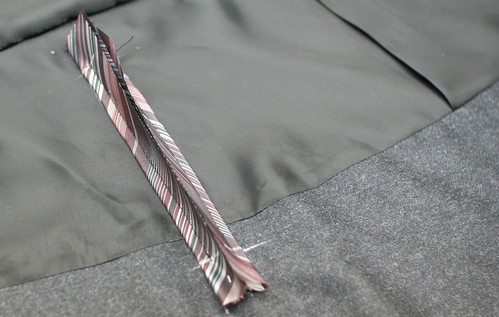
Notice how the pocket extends over the seam and onto the facing. That will allow me to tack the pocket bag invisibly onto the facing so it wont' shift, which will also later be tacked to the canvas, so all layers will move together. Some jackets have
what we call a french facing- rather than the straight seam as I have cut, the cloth will extend a little, and the pocket will be made on the cloth. There are many variations, but here is one;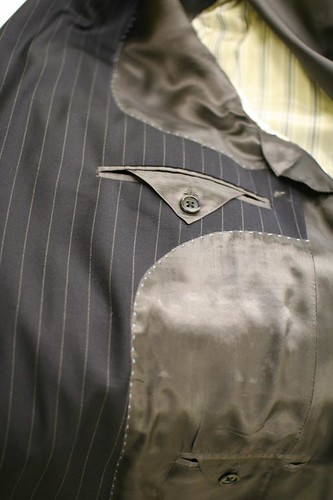
The reason I mention it is this- if you ever have to get your jacket relined, it is a much simpler operation if the pocket is made on a french facing. If the pocket extends beyound the seam like in the photo with the striped jets above, the facing will be cut in a Y shape where the pocket once was when I have removed the lining. Some tailors will just advance the seam 5/8" to cover it, but it is preferable not to. A small piece of fusible is placed behind the cut, the edges are very carefully aligned, and fused. When I have replaced the lining I will have to make a new pocket EXACTLY where the old one was, which is a job demanding great precision. Early in my career it was my job to do this sort of alteration in a factory, so from an alterations perspective, I MUCH prefer a french facing. However, I don't personally like the bulk of it which is why, for my own suits, I cut a straight facing.
So which method of pocket construction is better- by hand or machine? The hand-made pocket is certainly more attractive, softer, more discreet. The machine-made pocket is probably a lot stronger, but if you're not shoving heavy stuff in your pockets that probably doesn't matter. In this case, in my opinion, the difference is really only aesthetic.








3 comments:
I'm currently teaching myself to tailor in my spare time and have found your site so informative and inspiring, thank you for keeping it up!
Just found your website, and reading the back issues (so to speak). I love how you compare different methods - machine vs. hand, or different styles of tailoring. And your work is beautiful! Thanks for sharing it!
Hello thank you for post this valuable blog and it is very informative. I really enjoyed reading your blog and learn alot of things. Here check bespoke women's suits London if you like.
Post a Comment